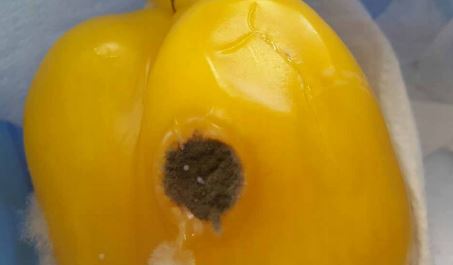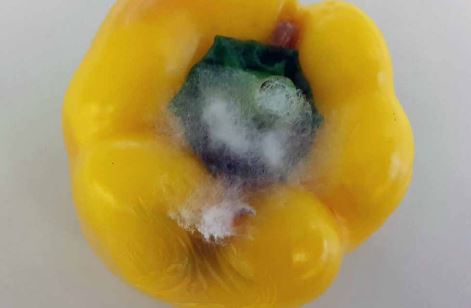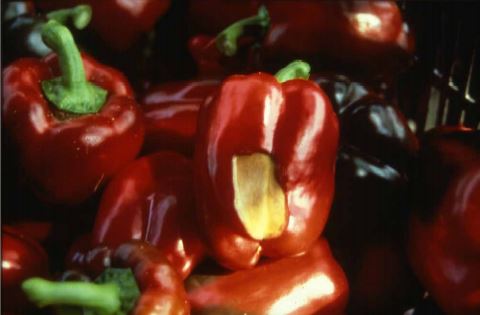Please click here to access the main AHDB website and other sectors.
- Home
- Knowledge library
- Minor fruit rots of pepper
Minor fruit rots of pepper
Learn to spot the signs and symptoms that appear on peppers when they are infected by one of the minor fruit rots.
This information was last updated in 2015.
Alternaria
Alternaria rot of peppers is caused by the fungus Alternaria alternata and may create lesions at the blossom end or on the side of fruit.
These initially appear water-soaked and grey in colour, becoming dark and wrinkled as spores develop.
Infection may not be visible externally, but mould could be present on seeds within the pepper if infection has occurred at flowering.
Storage and toxins
Infection occurs via injuries or senescing flowers and may continue to develop in storage.
Some strains can produce toxins.
Alternaria alternata is quite common in the UK, but Alternaria rot of pepper fruit has not been reported.
Cladosporium herbarum
Lesions on fruit are initially circular, firm, sunken and black, with a distinct brown border (see figure 1). Brownish-green to black spores are produced on the surface of the lesions in high humidity.
Only fruits where the skin has been weakened by chilling injury or sunscald are susceptible.

Figure 1. Cladosporium fruit rot usually causes circular dark-coloured lesion. © Tim O’Neill.
The spores of this pathogen can cause an allergic reaction in some people.
This fungus is quite common in the UK, but there are no reports on home-produced pepper fruit.
Colletotrichum
Also known as anthracnose, several species of Colletotrichum can cause rots on ripe peppers.
This rot begins as water-soaked spots, which progress to become dark and sunken.
Lesions are circular and may coalesce to form large areas of infection on fruit. Sporulation appears salmon-pink and is often in concentric circles.
Both unripe and mature fruit are susceptible, but infection is more readily visible in ripened fruit.
Where can it be found?
C. coccodes produces small, cup-shaped fruiting bodies that develop a slimy mass of spores.
C. coccodes is commonly present in UK soils. Infection is more likely in moist conditions, and wounded fruit is more susceptible.
Colletotrichum species can survive in plant debris and the soil for long periods of time.
Fruit infection may progress to infest seed.
Pythium
Several Pythium species can cause a rot on fruits, especially those in close contact with the ground in warm and wet areas.
Often known as ‘cottony leak’, because white, cotton-like mould growth accompanies a wet rot where rotted tissue may release juices. It commonly starts at the blossom end.
Sclerotinia
Sclerotinia rot of pepper is more common in temperate regions like the UK.
- It favours dew and moist conditions and can occur in conjunction with grey mould (Botrytis)
- Initial infection is visible as dark green, water-soaked lesions
- White mould growth occurs in warm and moist conditions and lesions can occur anywhere on the fruit (see figure 2)
- Infected tissue is soft and watery and infected fruit rots quickly.

Figure 2. Early stages of Scerotinia rot - characterised by fluffy white mycelium © Tim O’Neill.
Formation of Sclerotia
Sclerotia form within the mould as the rot progresses, resulting in degradation of the fruit to a watery mass.
The sclerotia are initially pale but become black and hard. Their size varies dependent on the species of Sclerotinia.
S. sclerotiorum is the most common species, with sclerotia approximately 2-10 mm.
Xanthomonas campestris
Xanthomonas campestris pv. vesicatoria, is a gram-negative bacterium that survives primarily in plant debris. It is capable of infecting all foliar parts of the plant.
Symptoms on pepper fruit may not be immediately apparent, as fruit abortion is common when infected with X. campestris.
Spots on fruit start as small, pale, and water-soaked, progressing to brown, scabby raised lesions.
The pathogen can also result in more sunscald as badly affected plants become defoliated.

Figure 3. Sunscald on pepper. ©Tim O’Neill.
Where is it found?
This disease is most common in Southern Europe (Southern France, Spain, Portugal, Israel) and North Africa where warm, humid conditions prevail.
It is mostly absent from cooler production areas in Europe, including the UK.
Xanthomonas campestris pv. vesicatoria appears on the A2 EPPO quarantine list, and its spread within the EU is prohibited.
Any suspected cases must be reported to Plant Health.

